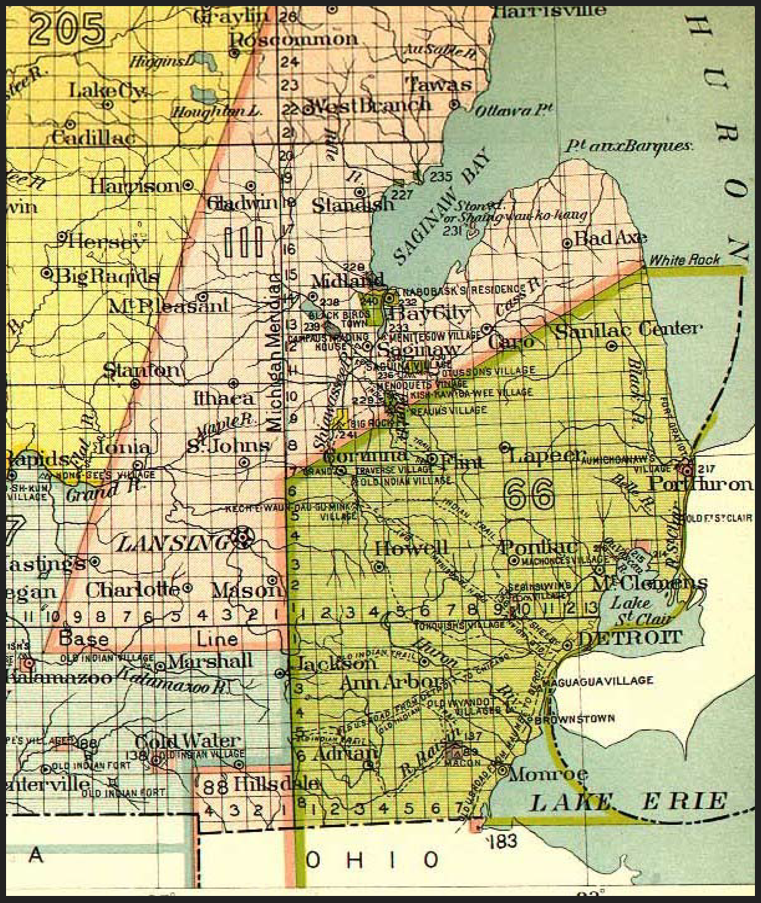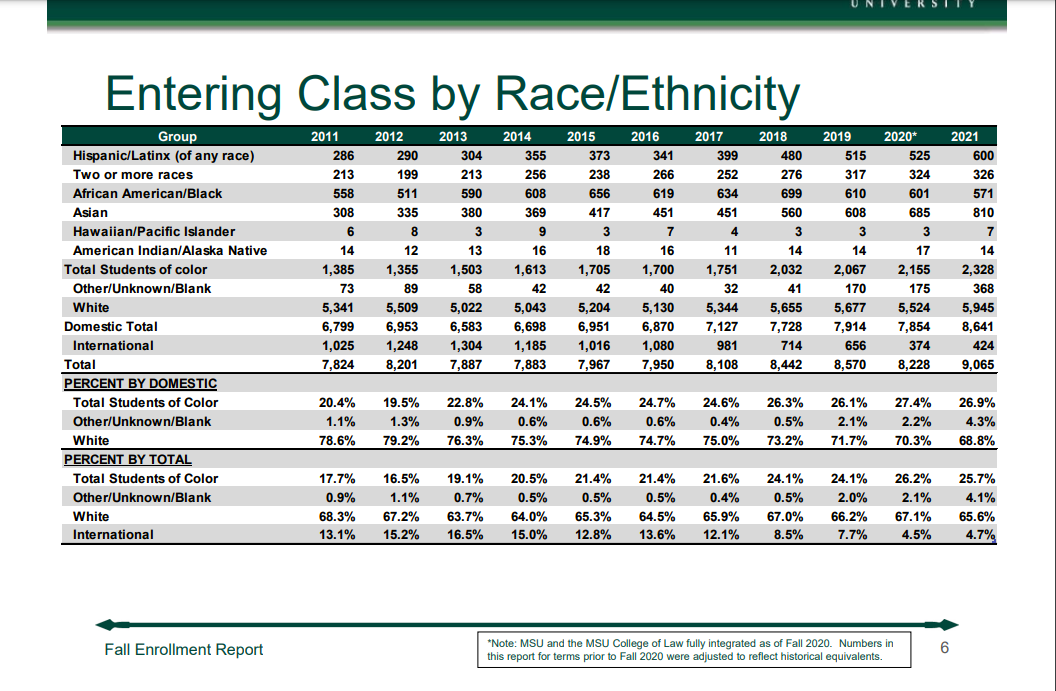NATIVE VISIBILITY AND RESOURCES AT MICHIGAN STATE UNIVERSITY
Sofia Rabiela
INTRODUCTION
Michigan State University, known as the “Pioneer Land Grant College,” is one of many universities that has gained land from the Morrill Act of 1862. This act was set in place to “donate” public land to universities so areas of studies such as agriculture could be expanded. In a self-reflective manner, Michigan State University does acknowledge that the land grant was implemented with the dismissal of the Anishinaabeg - The Fires Confederacy of Ojibwe, Odawa, and Potawatomi peoples. Even with the implemented Treaty of 1819, as referenced in the MSU Land Acknowledgement, it is most likely that these native peoples were coerced into an agreement that benefitted federal economy, universities, and non indigenous peoples. This particular study will be focusing on the recognition and resources that have been given to Indigenous Students and communities within the University as well as change that is on the rise.
UNIVERSITY RECOGNITION
LAND ACKNOWLEDGEMENT

Land acknowledgements are formal statements that are given in a multitude of settings such as emails, formal events, celebrations, performances, sporting events etc. These statements are given to shed light on the indigenous lands that the university occupies and that although there are treaties in place, pain and suffering were inflicted and continually inflicted upon these peoples. These acknowledgments also serve as a reminder that these people and tribes still exist in the state of Michigan and we should be aware of the policies set in place by the university that affect indigenous students and communities while simultaneously striving to improve them.
Michigan State University provides three land acknowledgements that can be used in different contexts. The briefest is the email signature land acknowledgment, which touches on two main points, the tribes in which the land it occupies, as well as the treaty in which the land was “given up.” THe second longest land acknowledgment is the “provisional” acknowledgment which is to be said before formal events or in print on published materials. This acknowledgment goes into more detail; recognizing that there are twelve federally recognized tribes in Michigan (although not by name) and that although they live here today, there was violence inflicted upon them (non-specific). Lastly, there is the promise for the future, that being holding the university accountable to attend to the needs of indigenous students and the community.
The longest of the three land acknowledgements was written in 2018 by the American Indian and Indigenous Studies (AIIS) department at MSU, and even though it is the most detailed of the three, AIIS is still looking to revise the land acknowledgement to include ways that will put these acknowledgements in action. The first difference between this acknowledgement and the others is the issue with MSU boasting about being, “The Nation’s Pioneer Land Grant College,” when the university’s academic success that came with gaining this land also simultaneously coincided with the genocide of Indigenous peoples. The twelve federally recognized tribes are listed by name as well as other tribes that are not federally recognized. Many violences against Indigenous people are described, and although difficult to hear, it is necessary to get the point across that this land that the borders of the state of Michigan reside on came about through violence and the removal of people and their cultures. One of the most important sentences of this land acknowledgement reads, “We collectively understand that offering Land Acknowledgements or Land Recognitions do not absolve settler-colonial privilege or diminish colonial structures of violence, at either the individual or institutional level.” This statement lets those reading, listening, or speaking this acknowledgement know that this land acknowledgement itself is not enough and personally and as an institution we have a duty to educate ourselves and support indigenous communities.
NATIVE AMERICAN INSTITUTE (NAI)
The first organization that functioned in favor of native students at the university, the first being the Native American Institute (NAI) in 1981. NAI was originally established to facilitate educational initiatives as well as act as a liaison between the indigenous students at the university as well as indigenous communities across the state of Michigan. Indigenous students first began attending Michigan State in the 1960s, so when the institute first formed, issues such as the Anishinaabe fishing rights and other economic developments were tackled first in regards to student life. NAI now focuses primarily on community outreach, pertaining to maintaining good relationships between the university and Michigan tribes as well as promoting and aiding in the Native Americans wanting to pursue higher education.
AMERICAN INDIAN AND INDIGENOUS STUDIES (AIIS)
The second organization was Michigan State University’s American Indian and Indigenous Studies area, which was formed in 2000 in efforts to enhance the knowledge and courses provided in academia regarding Native peoples of the US and Canada. Along with its initial formation AIIS added their addition “I” for Indigneous in 2016 as they recognize “Indian” as a term primarily used by governments while “Indigenous'' is more inclusive to tribes that may not be federally recognized as well as tribal group not specific to the United States (meaning Canada and Mexico). AIIS offers an undergraduate major and minor, and although there is no graduate degree yet, a graduate certificate is offered. Through these degrees, AIIS strives to teach students not only about the history and contemporary issues of these very diverse cultures, but also how these cultures can function in multiple disciplines. With this in mind, AIIS strives to meet the needs of indigenous students while at school, but also provide all students with the knowledge and tools to serve as allies to contemporary indigenous communities outside of the school setting.
UNIVERSITY RESOURCES
TUITION WAIVER
Michigan State University Offers two scholarship options specific to Native students who choose to attend this university. The first option being the Michigan Indian Tuition Waiver, which offers full tuition covered if all requirements are met by university and legislative standards. These qualifications come from the Michigan Public Act 174 of 1976, and an applicant must be native to the state of Michigan, or live in the state of Michigan minimum 1 full year prior to enrollment, be at least a quarter native blood of a federally recognized tribe, and be enrolled with said federally recognized tribe(s).
The second scholarship option is the Maynard Kennedy Turtle Island Acknowledgement Scholarship which allows a limited number of incoming native students the opportunity to only pay in-state tuition rather than out-of-state tuition. The qualification of this scholarship application is only the need to provide one form of tribal documentation; which may include: "a certificate degree of Indian blood, a photocopy of Tribal ID, a photocopy of Indian Status Card, a letter of Tribal Certification, Proof of citizenship in one of the provincial affiliates of the Métis National Council, or Enrollment card from one of the Inuit Land Claims Agreements.”
Although the scholarship opportunities to cover part or all of tuition is nice, you can see that the qualifications for these scholarships can be very difficult to navigate. With there only being 574 federally recognized tribes in the United States and only 12 of those being in the state of Michigan, some indigenous students cannot qualify. Schools are also at liberty to pick which qualifications they would like to accept and in terms of Michigan State, the state of Michigan residency time has proven to be an issue. Along with these issues with qualifications, over the past 11 years, there have only been 14 Native American students on average per class. These low numbers may come from recruitment issues but more than likely, accessibility issues on campus and with these harsh restrictions on scholarships.

STUDENT ORGANIZATIONS

Michigan State University has three primary Indigenous student organizations on campus that offer guidance to students, faculty, and the surrounding community. The first of these organizations is the Native American Indigenous Student Organization (NAISO), whose mission is to diversify the social and academic culture both on and off campus. NAISO has and continues to advocate for issues such as removing the “Pioneer Land Grant University” from Michigan state entrances, suggesting to hire a special advisor to the President of the university for tribal relations, and implementing a University definition of hate speech just to name a few. The second of these organizations is the Indigenous Graduate Student Collective (IGSC), which promotes scholarships and the attention to caring for Indigenous Graduate students well beings in all facets on and off campus. The third organization is the Native American Law Students Association (NALSA) which specifically implements diversity into the college of Law and provides assistance to Native Students in this college. This organization is especially important as there are so many native issues with the federal government that are not easily accessible to tribes as there are not many lawyers that care for native issues and promoting a future for people of these communities in this field can aid greatly in federal law change for future generations.
CONCLUSION
Michigan State University as a whole is not the worst university in regards to Native American recognition and resources but it is far from the best. Even the best university still has work to do, and while student organizations can pave the way for change, the people in power at these institutions need to open their eyes to the realities of these vastly diverse, beautiful communities that reside within their students on campus and across this whole country. As a university, MSU shouldn’t be boasting about being the first school that benefited from the unfair possession of indigenous land, but rather should strive to set the example of how indigenous communities and studies are taught and represented in a positive and healthy way on and off campus.
REFERENCES
- “About.”Native American Institute. About, https://nai.msu.edu/about.
- Bonsall, Beth. “Taking Steps to Use the MSU Land Acknowledgement More Broadly.” Office of Diversity, Equity and Inclusion, 21 Jan. 2022, https://www.canr.msu.edu/news/taking-steps-to-use-the-msu-land-acknowledgement-more-broadly.
- Fall Enrollment - Michigan State University. https://opb.msu.edu/functions/institution/documents/FallEnrollment.pdf.
- “Guide to Land Acknowledgements.” Native American Institute. https://nai.msu.edu/about/guide-to-land-acknowledgements.
- “History & Land-Grant Identity.” Michigan State University, https://brand.msu.edu/storytelling/msu-history.
- “Land Acknowledgement.” American Indian and Indigenous Studies, https://aiis.msu.edu/land/.
- “Land Grant Identity.” Michigan State University, https://strategicplan.msu.edu/mission#landgrant.
- “Mission and Objectives.” American Indian and Indigenous Studies, https://aiis.msu.edu/about/mission-and-objective/.
- MSU American and Indigenous Studies. Land Acknowledgement, 2018, https://nai.msu.edu/projects/reciprocal-research-guidebook/land-acknowledgement.
- “MSU & the 1819 Treaty of Saginaw.” Michigan State University Native American Institute, https://nai.msu.edu/about/msu-the-1819-treaty-of-saginaw.
- “Native American Scholarship and Tuition Waiver.” Michigan State University Office of Admissions, https://admissions.msu.edu/cost-aid/scholarships/freshman/native-american.
- “Native History at MSU.” American Indian and Indigenous Studies, https://aiis.msu.edu/about/history/.
- “Student Organizations.” American Indian and Indigenous Studies, https://aiis.msu.edu/community/student-organizations/.
- Waiver for Tuition for North American Indians. https://www.legislature.mi.gov/(S(f4f0ll25rr4u34554b0tjyim))/documents/mcl/pdf/mcl-act-174-of-1976.pdf.
- Wigand, Emerson. “Advocates Want Free College for More Indigenous Students .” Spartan Newsroom, 14 Jan. 2022, https://news.jrn.msu.edu/2021/11/advocates-want-free-college-for-more-indigenous-students/.